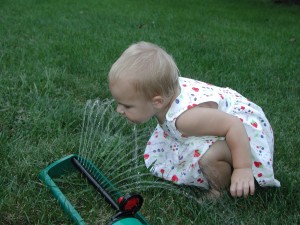The mercury is rising all across the country and homeowners are asking: what’s the right amount of water for my lawn?
Of course, this is a complicated question and doesn’t take into account the thousands of variations between home grass: the species of grass, the climate in the area, and even the amount of shade and sun the lawn gets. There are several factors to consider when watering your lawn but one thing’s for certain. This time of year it’s imperative to have a plan – forgetting to water your lawn just once or twice can spell disaster for your grass.
Factoring in the Weather:
Obviously, the hotter it is, the more water your lawn is going to need. Just like with potted plants, if your lawn’s base soil feels dry it likely needs some moisture. Many people wrongly assume a strong rain “counts” as watering the lawn. In fact, anything less than about 2″ of rain at once really shouldn’t be counted towards your lawn’s water total. As a general rule, southern lawns need to be watered 2-3 times a week for about 40-minutes a stretch whereas more northern climates only require 1-2 waterings a week for about 30-minutes.
Factoring in the Type of Grass:
Some grass types are far heartier than others. Fescue and Kentucky Bluegrass, for example, do well in cold climates and naturally need less nutrients than other grasses. In every part of the country, grass is generally planted based on its dormancy seasons. Summer grasses in the hottest climates tend to be “dormant” which means they’re not dead, but more like hibernating. Talk to your local lawn care professional about your type of grass and certainly consult an expert before laying sod.
Factoring in Other Care:
How often you water your lawn will play a large part in how often you mow. The more you water the more your grass is going to grow, therefore the more you’ll need to mow. It’s best if you can leave the clippings where they lay when you mow as the old grass actually nourishes the cut grass. It’s also advisable to leave the blades at least 3″ tall for the overall health of your yard. Of course, longer grass will need more water. If your grass is browning, resist the urge to overwater. Use a rain gauge to see how much you’re watering at any given time and avoid applying more than about 2″ of water during any one watering.
Have more questions about lawn care? Contact a lawn pro in your neighborhood to talk about your options.
